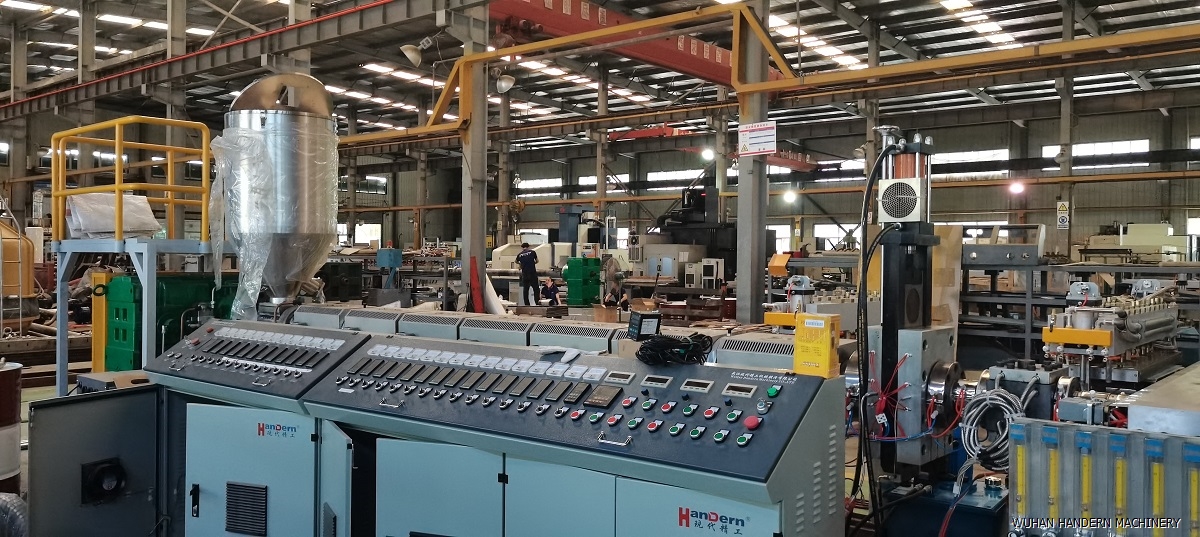Extrusion molding process of hollow board production line
DATE:2023/11/3 10:09:21 / READ: / SOURCE:This station
The extrusion forming process of the hollow board production line is one of the key steps in the production of hollow boards. The following will provide a detailed description of the extrusion molding process of the hollow board production line.
Next is the extrusion process. The melted plastic melt is fed into the screw cavity of the extruder. The extruder is the core equipment in the hollow plate production line, which is composed of screws and screw barrels. During the rotation of the screw, the plastic melt is pushed to the head of the screw. The mold at the screw head determines the shape and size of the extruded hollow plate.
During the extrusion process, the rotation of the screw and the back pressure push the plastic melt into the feed area of the mold. In the feeding area, the plastic melt is compressed and heated to reach higher temperatures and pressures. Subsequently, the plastic melt enters the extrusion port of the mold, and through the shape and size of the extrusion port, the plastic melt is extruded into the shape of a hollow plate.
During the extrusion process, it is necessary to control the extrusion speed and temperature. The control of extrusion speed affects the thickness and surface quality of the hollow board, and either too fast or too slow can have an impact on product quality. The main purpose of temperature control is to maintain the fluidity and stability of plastic melts, as high or low temperatures can lead to difficulties in extrusion or a decrease in product quality.
Finally, there is cooling and solidification. The extruded hollow board needs to be cooled and cured to achieve the required performance and shape stability. At the outlet of the extruder, a cooling device is usually installed to cool the extruded hollow plate through water cooling or air cooling. After cooling, the hollow board will gradually solidify, making its shape stable.
During the extrusion molding process, some factors need to be considered, such as mold design and selection, parameter adjustment of the extruder, raw material ratio, and melting control. Reasonable mold design and extruder parameter adjustment can make the extrusion molding process more stable and efficient. At the same time, precise control of the proportion of raw materials and melting control can ensure the quality and performance of the hollow board.
In summary, the extrusion molding process of the hollow board production line includes steps such as raw material melting, extrusion, and cooling solidification. Through reasonable process control and equipment adjustment, hollow board products with stable performance and good appearance can be produced. Extrusion molding is the core process in the production line of hollow panels, which has a significant impact on the quality and efficiency of hollow panels.
Extrusion molding is the process of extruding molten plastic raw materials through a mold to form a hollow plate. In the hollow board production line, extrusion molding includes steps such as raw material melting, extrusion, and cooling solidification.

Next is the extrusion process. The melted plastic melt is fed into the screw cavity of the extruder. The extruder is the core equipment in the hollow plate production line, which is composed of screws and screw barrels. During the rotation of the screw, the plastic melt is pushed to the head of the screw. The mold at the screw head determines the shape and size of the extruded hollow plate.
During the extrusion process, the rotation of the screw and the back pressure push the plastic melt into the feed area of the mold. In the feeding area, the plastic melt is compressed and heated to reach higher temperatures and pressures. Subsequently, the plastic melt enters the extrusion port of the mold, and through the shape and size of the extrusion port, the plastic melt is extruded into the shape of a hollow plate.
During the extrusion process, it is necessary to control the extrusion speed and temperature. The control of extrusion speed affects the thickness and surface quality of the hollow board, and either too fast or too slow can have an impact on product quality. The main purpose of temperature control is to maintain the fluidity and stability of plastic melts, as high or low temperatures can lead to difficulties in extrusion or a decrease in product quality.
Finally, there is cooling and solidification. The extruded hollow board needs to be cooled and cured to achieve the required performance and shape stability. At the outlet of the extruder, a cooling device is usually installed to cool the extruded hollow plate through water cooling or air cooling. After cooling, the hollow board will gradually solidify, making its shape stable.
During the extrusion molding process, some factors need to be considered, such as mold design and selection, parameter adjustment of the extruder, raw material ratio, and melting control. Reasonable mold design and extruder parameter adjustment can make the extrusion molding process more stable and efficient. At the same time, precise control of the proportion of raw materials and melting control can ensure the quality and performance of the hollow board.
In summary, the extrusion molding process of the hollow board production line includes steps such as raw material melting, extrusion, and cooling solidification. Through reasonable process control and equipment adjustment, hollow board products with stable performance and good appearance can be produced. Extrusion molding is the core process in the production line of hollow panels, which has a significant impact on the quality and efficiency of hollow panels.
Author:admin




